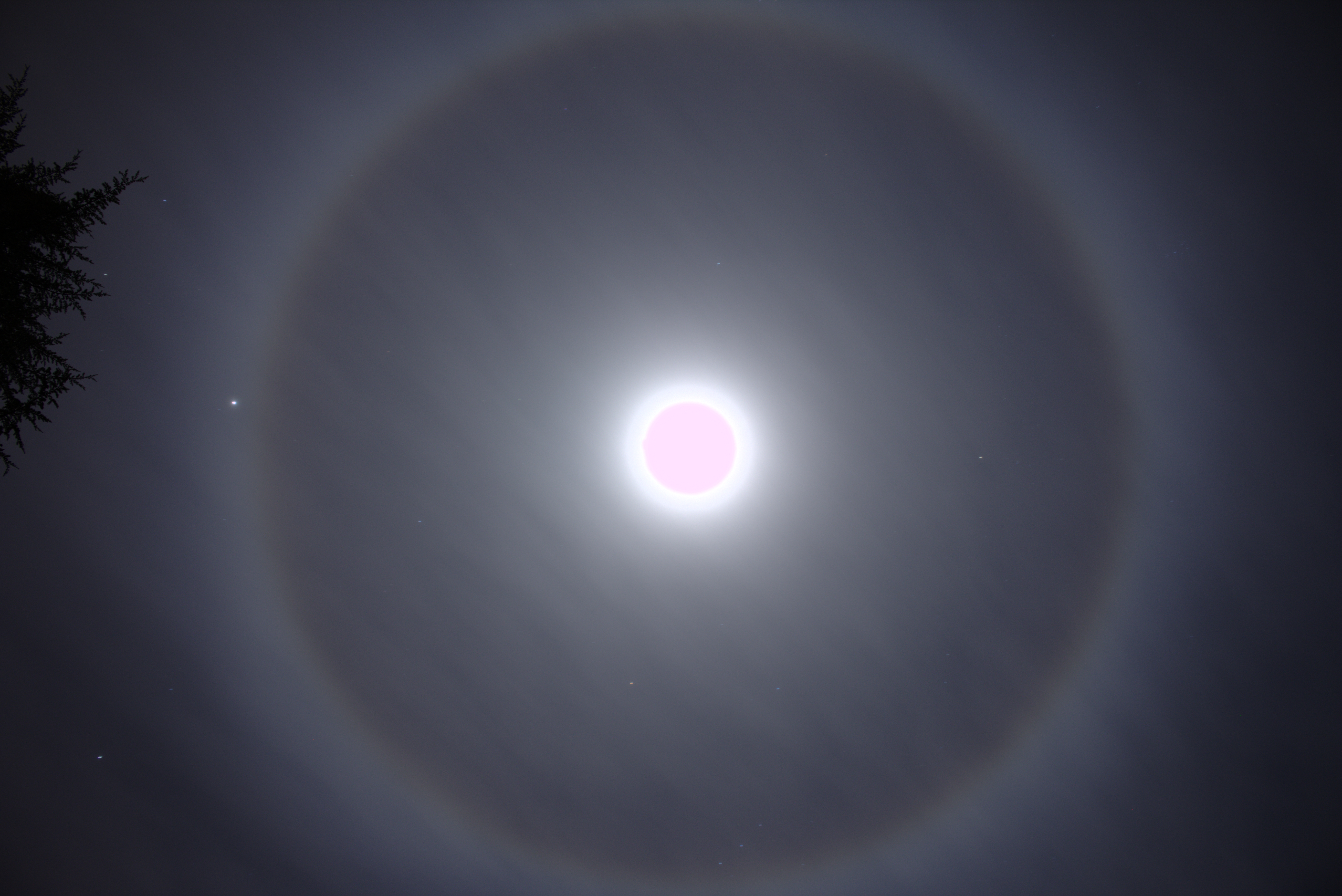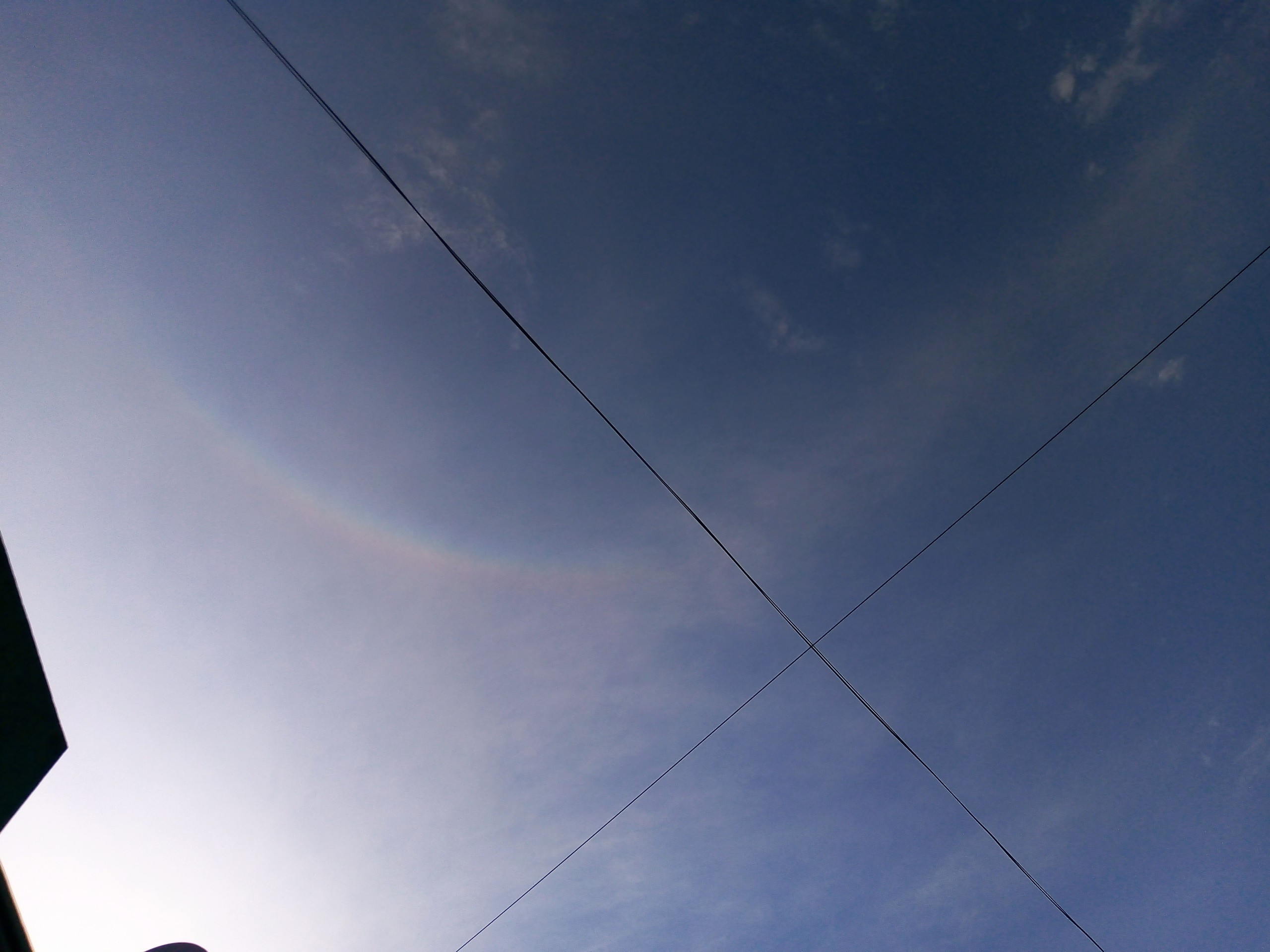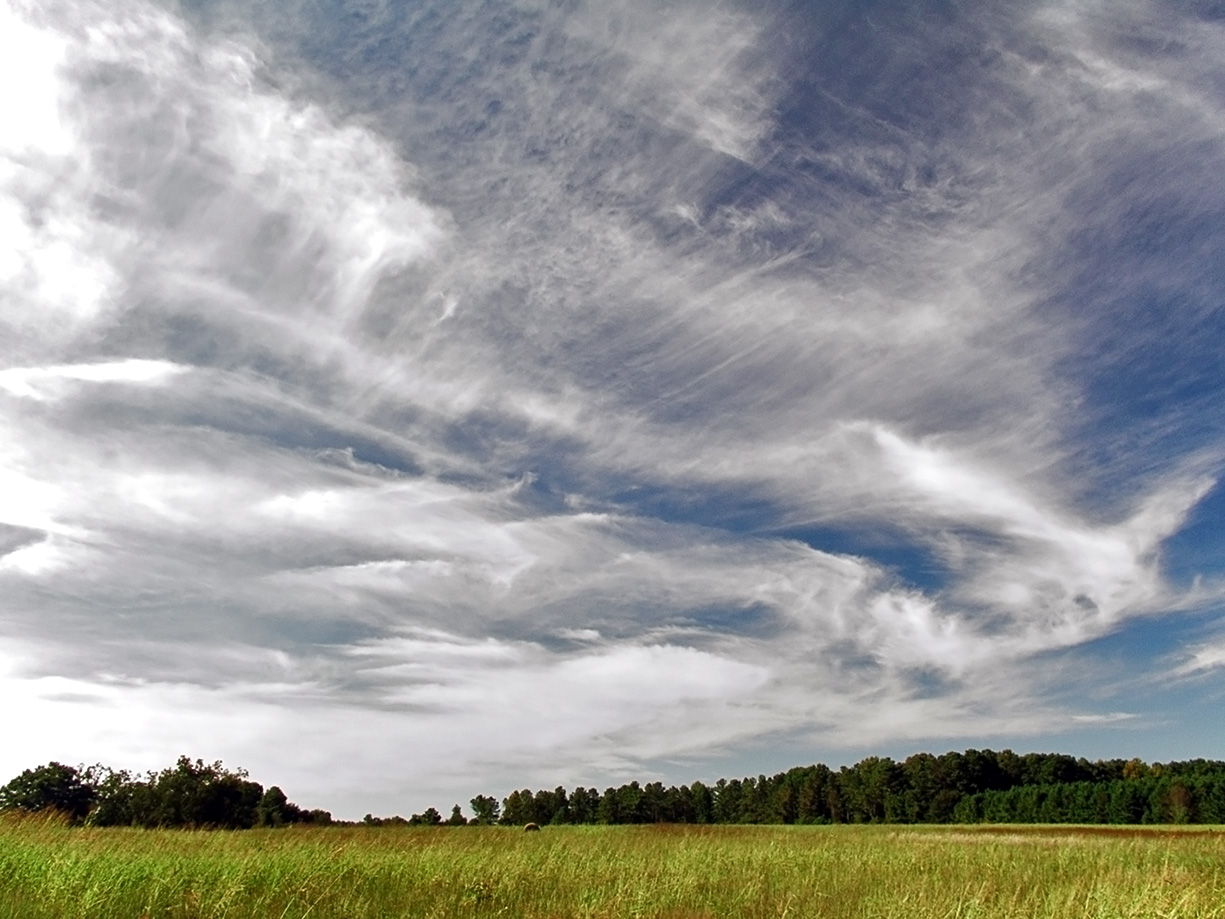|
120° Parhelion
A 120° parhelion (plural: 120° parhelia) is a relatively rare halo, an optical phenomenon occasionally appearing along with very bright sun dogs (also called parhelia) when ice crystal-saturated cirrus clouds fill the atmosphere. The 120° parhelia are named for appearing in pair on the parhelic circle ±120° from the sun. (including a HaloSim simulation.) When visible, 120° parhelia appear as white-bluish bright spots on the white parhelic circle and are the product of at least two interior reflections in the hexagonal ice crystals. Their colour together with them being rather obscure can make observing them difficult as they tend to fuse with the clouds in the sky. See also * Liljequist parhelion A Liljequist parhelion is a rare halo, an optical phenomenon in the form of a brightened spot on the parhelic circle approximately 150–160° from the sun; i.e., between the position of the 120° parhelion and the anthelion. While the sun touches ... * Subhelic arc Referen ... [...More Info...] [...Related Items...] OR: [Wikipedia] [Google] [Baidu] |
Anthelion 120 Parhelion Vädersolstavlan
An anthelion (plural anthelia, from late Greek ανθηλιος, "opposite the sun") is a rare optical phenomenon of the halo family. It appears on the parhelic circle opposite to the sun as a faint white spot, not unlike a sundog, and may be crossed by an X-shaped pair of diffuse arcs. How anthelia are formed is disputed. Walter Tape, among others, has argued they are not separate haloes, but simply where various haloes caused by horizontally oriented column-shaped ice crystals coincide on the parhelic circle to create a bright spot. If this theory is correct, anthelia should only appear together with these other haloes. However, anthelia occur unaccompanied by other plate crystal haloes, thus scientists have produced alternative explanations. The Dutch professor S.W. Visser proposed they form by two exterior light reflections in quadrangular prisms, while Robert Greenler has suggested two interior reflections in column-shaped crystals produces the phenomenon. While the anthelio ... [...More Info...] [...Related Items...] OR: [Wikipedia] [Google] [Baidu] |
Halo (optical Phenomenon)
A halo is an optical phenomenon produced by light (typically from the Sun or Moon) interacting with ice crystals suspended in the atmosphere. Halos can have many forms, ranging from colored or white rings to arcs and spots in the sky. Many of these appear near the Sun or Moon, but others occur elsewhere or even in the opposite part of the sky. Among the best known halo types are the circular halo (properly called the 22° halo), light pillars, and sun dogs, but many others occur; some are fairly common while others are extremely rare. The ice crystals responsible for halos are typically suspended in cirrus or cirrostratus clouds in the upper troposphere (), but in cold weather they can also float near the ground, in which case they are referred to as diamond dust. The particular shape and orientation of the crystals are responsible for the type of halo observed. Light is reflected and refracted by the ice crystals and may split into colors because of dispersion. The ... [...More Info...] [...Related Items...] OR: [Wikipedia] [Google] [Baidu] |
Optical Phenomenon
Optical phenomena are any observable events that result from the interaction of light and matter. All optical phenomena coincide with quantum phenomena. Common optical phenomena are often due to the interaction of light from the sun or moon with the atmosphere, clouds, water, dust, and other particulates. One common example is the rainbow, when light from the sun is reflected and refracted by water droplets. Some phenomena, such as the green ray, are so rare they are sometimes thought to be mythical. Others, such as Fata Morganas, are commonplace in favored locations. Other phenomena are simply interesting aspects of optics, or optical effects. For instance, the colors generated by a prism are often shown in classrooms. List Optical phenomena include those arising from the optical properties of the atmosphere; the rest of nature (other phenomena); of objects, whether natural or human-made (optical effects); and of our eyes (Entoptic phenomena). Also listed here are unexpla ... [...More Info...] [...Related Items...] OR: [Wikipedia] [Google] [Baidu] |
Sun Dog
A sun dog (or sundog) or mock sun, also called a parhelion (plural parhelia) in meteorology, is an atmospheric optical phenomenon that consists of a bright spot to one or both sides of the Sun. Two sun dogs often flank the Sun within a 22° halo. The sun dog is a member of the family of halos caused by the refraction of sunlight by ice crystals in the atmosphere. Sun dogs typically appear as a pair of subtly colored patches of light, around 22° to the left and right of the Sun, and at the same altitude above the horizon as the Sun. They can be seen anywhere in the world during any season, but are not always obvious or bright. Sun dogs are best seen and most conspicuous when the Sun is near the horizon. Formation and characteristics Sun dogs are commonly caused by the refraction and scattering of light from horizontally oriented plate-shaped hexagonal ice crystals either suspended in high and cold cirrus or cirrostratus clouds, or drifting in freezing moist air at low ... [...More Info...] [...Related Items...] OR: [Wikipedia] [Google] [Baidu] |
Ice Crystal
Ice crystals are solid ice exhibiting atomic ordering on various length scales and include hexagonal columns, hexagonal plates, dendritic crystals, and diamond dust. Formation The hugely symmetric shapes are due to depositional growth, namely, direct deposition of water vapor onto the ice crystal. Depending on environmental temperature and humidity, ice crystals can develop from the initial hexagonal prism into numerous symmetric shapes. Possible shapes for ice crystals are columns, needles, plates and dendrites. If the crystal migrates into regions with different environmental conditions, the growth pattern may change, and the final crystal may show mixed patterns. Ice crystals tend to fall with their major axis aligned along the horizontal, and are thus visible in polarimetric weather radar signatures with enhanced (positive) differential reflectivity values. Electrification of ice crystals can induce alignments different from the horizontal. Electrified ice crystals are ... [...More Info...] [...Related Items...] OR: [Wikipedia] [Google] [Baidu] |
Cirrus Cloud
Cirrus ( cloud classification symbol: Ci) is a genus of high cloud made of ice crystals. Cirrus clouds typically appear delicate and wispy with white strands. Cirrus are usually formed when warm, dry air rises, causing water vapor deposition onto rocky or metallic dust particles at high altitudes. Globally, they form anywhere between above sea level, with the higher elevations usually in the tropics and the lower elevations in more polar regions. Cirrus clouds can form from the tops of thunderstorms and tropical cyclones and sometimes predict the arrival of rain or storms. Although they are a sign that rain and maybe storms are on the way, cirrus themselves drop no more than falling streaks of ice crystals. These crystals dissipate, melt, and evaporate as they fall through warmer and drier air and never reach ground. Cirrus clouds warm the earth, potentially contributing to climate change. A warming earth will likely produce more cirrus clouds, potentially resulting in a self ... [...More Info...] [...Related Items...] OR: [Wikipedia] [Google] [Baidu] |
Parhelic Circle
A parhelic circle is a type of halo, an optical phenomenon appearing as a horizontal white line on the same altitude as the sun, or occasionally the Moon. If complete, it stretches all around the sky, but more commonly it only appears in sections. If the halo occurs due to light from the moon rather than the sun, it is known as a paraselenic circle. Even fractions of parhelic circles are less common than sun dogs and 22° halos. While parhelic circles are generally white in colour because they are produced by reflection, they can however show a bluish or greenish tone near the 120° parhelia and be reddish or deep violet along the fringes. (including an excellent HaloSim simulation of a parhelic circle.) Parhelic circles form as beams of sunlight are reflected by vertical or almost vertical hexagonal ice crystals. The reflection can be either external (e.g. without the light passing through the crystal) which contributes to the parhelic circle near the sun, or internal (one or ... [...More Info...] [...Related Items...] OR: [Wikipedia] [Google] [Baidu] |
Hexagon
In geometry, a hexagon (from Greek , , meaning "six", and , , meaning "corner, angle") is a six-sided polygon. The total of the internal angles of any simple (non-self-intersecting) hexagon is 720°. Regular hexagon A ''regular hexagon'' has Schläfli symbol and can also be constructed as a truncated equilateral triangle, t, which alternates two types of edges. A regular hexagon is defined as a hexagon that is both equilateral and equiangular. It is bicentric, meaning that it is both cyclic (has a circumscribed circle) and tangential (has an inscribed circle). The common length of the sides equals the radius of the circumscribed circle or circumcircle, which equals \tfrac times the apothem (radius of the inscribed circle). All internal angles are 120 degrees. A regular hexagon has six rotational symmetries (''rotational symmetry of order six'') and six reflection symmetries (''six lines of symmetry''), making up the dihedral group D6. The longest diagonals ... [...More Info...] [...Related Items...] OR: [Wikipedia] [Google] [Baidu] |
Liljequist Parhelion
A Liljequist parhelion is a rare halo, an optical phenomenon in the form of a brightened spot on the parhelic circle approximately 150–160° from the sun; i.e., between the position of the 120° parhelion and the anthelion. While the sun touches the horizon, a Liljequist parhelion is located approximately 160° from the sun and is about 10° long. As the sun rises up to 30° the phenomenon gradually moves towards 150°, and as the sun reaches over 30° the optical effect vanishes. The parhelia are caused by light rays passing through oriented plate crystals. . The phenomenon was first observed by Gösta Hjalmar Liljequist in 1951 at Maudheim, Antarctica during the Norwegian–British–Swedish Antarctic Expedition in 1949–1952. It was then simulated by Dr. Eberhard Tränkle (1937–1997) and Robert Greenler in 1987 and theoretically explained by Walter Tape in 1994. A theoretical and experimental investigation of the Liljequist parhelion caused by perfect hexagonal plate ... [...More Info...] [...Related Items...] OR: [Wikipedia] [Google] [Baidu] |
Subhelic Arc
A subhelic arc is a rare halo, formed by internal reflection through ice crystals, that curves upwards from the horizon and touches the tricker arc above the anthelic point. Subhelic arcs result from ray entrance and exit through prism end faces with two intermediate internal reflections. Formation A subhelic arc is formed when sun rays enter one end face of an ice crystal in singly oriented columns and Parry columns, reflect off two of the crystals side faces, and exits the crystal through the opposite end face. The ray leaves the crystal at the exact opposite angle, resulting in a net deviation angle of 120°, the angle for the formation of 120° parhelia.Cowley, ''South Pole Halos - Zenith View'' The subhelic arc touches the top of the tricker arc, an indication the two have closely related ray paths.Cowley, ''South Pole Halos - Anthelic View'' The subhelic arc crosses the parhelic circle at an acute angle, and at a sun elevation of 27° it passes exactly through the ... [...More Info...] [...Related Items...] OR: [Wikipedia] [Google] [Baidu] |





